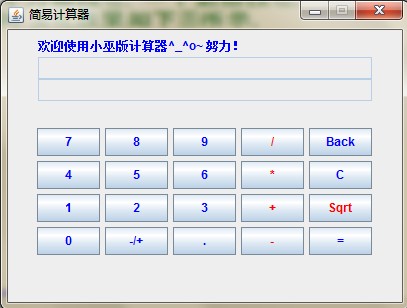
Schreiben Sie eine Anwendung, die einen Taschenrechner simuliert, indem Sie ein Bedienfeld- und Rasterlayout verwenden und ein Textfeld, 10 Ziffernschaltflächen (0–9), 4 Additions-, Subtraktions-, Multiplikations- und Divisionsschaltflächen, eine Gleichheitszeichenschaltfläche und eine Löschschaltfläche hinzufügen , Eine Quadratwurzel-Schaltfläche und eine Rücktaste erfordern die Anzeige der Berechnungsformel und der Ergebnisse im Textfeld. Der Effekt ist wie in der folgenden Abbildung dargestellt.
Code für einen einfachen Java-Rechner:
import javax.swing.*;
import javax.swing.JTextField;
import java.awt.*;
import java.awt.event.*;
import java.lang.*;
import java.awt.Color;
public class Ex5_2 extends JFrame implements ActionListener
{
private JPanel p1 = new JPanel(); //创建面板
private JPanel p2 = new JPanel();
private JTextField t1; //文本框1用来显示输入信息
private JTextField t2; //文本框2用来显示结果信息
private JLabel label; //标签信息
StringBuffer str; //显示屏所显示的字符串
double x,y; //x和y都是运算数
int z; //Z表示单击了那一个运算符.0表示"+",1表示"-",2表示"*",3表示"/"
private JButton b[] = new JButton[12]; //创建一个有12个按钮的数组
private JButton b1,b2,b3,b4,b5,b6,b7,b8; //算术功能按钮
public Ex5_2()
{
super("简易计算器"); //窗口名称
Container c = getContentPane(); //创建内容面板对象
t1 = new JTextField(30);
t1.setEditable(false); //只能显示,不能编辑
t2 = new JTextField(30);
t2.setEditable(false); //只能显示,不能编辑
label = new JLabel("欢迎使用小巫版计算器^_^o~ 努力!");
label.setForeground(Color.blue);
//创建一个空字符串缓冲区
str=new StringBuffer();
p2.add(label); //添加标签到面板
p2.add(t2); //添加文本框到面板
p2.add(t1); //添加文本框到面板
p2.setLayout(new GridLayout(4,1)); //把面扳布局为4行1列
for(int i=0;i<10;i++) //分别为数组中0~9号的按钮设置标签,并注册监听器
{
String s=""+i;
b[i]= new JButton(s);
b[i].addActionListener(this);
}
//实例化各个按钮
b[10]= new JButton("-/+"); b[11]= new JButton(".");
b1= new JButton("/"); b2= new JButton("Back");
b3= new JButton("*"); b4= new JButton("C");
b5= new JButton("+"); b6= new JButton("Sqrt");
b7= new JButton("-"); b8= new JButton("=");
//设置按钮前景色
for(int i=0;i<12;i++)
{
b[i].setForeground(Color.blue);
}
b1.setForeground(Color.red); b3.setForeground(Color.red);
b5.setForeground(Color.red); b7.setForeground(Color.red);
b2.setForeground(Color.blue); b4.setForeground(Color.blue);
b6.setForeground(Color.red); b8.setForeground(Color.blue);
//添加到面板
p1.add(b[7]); p1.add(b[8]); p1.add(b[9]); p1.add(b1); p1.add(b2);
p1.add(b[4]); p1.add(b[5]); p1.add(b[6]); p1.add(b3); p1.add(b4);
p1.add(b[1]); p1.add(b[2]); p1.add(b[3]); p1.add(b5); p1.add(b6);
p1.add(b[0]); p1.add(b[10]); p1.add(b[11]);p1.add(b7);p1.add(b8);
p1.setLayout(new GridLayout(4,5,5,5));
//注册监听器
b[10].addActionListener(this); b[11].addActionListener(this);
b1.addActionListener(this); b2.addActionListener(this);
b3.addActionListener(this); b4.addActionListener(this);
b5.addActionListener(this); b6.addActionListener(this);
b7.addActionListener(this); b8.addActionListener(this);
//将面板添加到内容面板
c.add(p2);
c.add(p1);
c.setLayout(new FlowLayout()); //设置为顺序布局
setDefaultCloseOperation(JFrame.EXIT_ON_CLOSE); //设置窗口关闭动作
setVisible(true); //设置为可见
setResizable(false); //禁止调整框架大小
setSize(400,300); //设置窗口大小
}
//主方法实现创建一个窗口
public static void main(String[] args)
{ Ex5_2 f = new Ex5_2(); }
//按钮的事件处理
public void actionPerformed(ActionEvent e)
{
try
{
if(e.getSource()==b4) //选择"C"清零
{
t1.setText("0"); //把文本框清零
t1.setHorizontalAlignment(JTextField.RIGHT); //文本对齐右边
str.setLength(0); //清空字符串缓冲区以准备接收新的输入运算数
}
else if(e.getSource()==b[10])//单击"+/-"选择输入的运算数是正数还是负数
{
x=Double.parseDouble(t1.getText().trim());//trim函数作用是去掉字符串中的空格
t1.setText(""+(-x));
t1.setHorizontalAlignment(JTextField.RIGHT);
}
else if (e.getSource()==b5)//单击加号按钮获得x的值和z的值并清空y的值
{
x=Double.parseDouble(t1.getText().trim());
str.setLength(0);
y=0d;
z=0;
}
else if(e.getSource()==b7)//单击减号按钮获得x的值和z的值并清空y的值
{
x=Double.parseDouble(t1.getText().trim());
str.setLength(0);
y=0d;
z=1;
}
else if(e.getSource()==b3)//单击乘号按钮获得x的值和z的值并清空y的值
{
x=Double.parseDouble(t1.getText().trim());
str.setLength(0);
y=0d;
z=2;
}
else if(e.getSource()==b1)//单击除号按钮获得x的值和z的值并清空y的值
{
x=Double.parseDouble(t1.getText().trim());
str.setLength(0);
y=0d;
z=3;
}
else if(e.getSource()==b8)//单击等号按钮输出计算结果
{
str.setLength(0);
switch(z)
{
case 0: t1.setText(""+(x+y)); t1.setHorizontalAlignment(JTextField.RIGHT);break;
case 1: t1.setText(""+(x-y)); t1.setHorizontalAlignment(JTextField.RIGHT);break;
case 2: t1.setText(""+(x*y)); t1.setHorizontalAlignment(JTextField.RIGHT);break;
case 3: t1.setText(""+(x/y)); t1.setHorizontalAlignment(JTextField.RIGHT);break;
}
}
else if(e.getSource()==b[11])//单击"."按钮输入小数
{
if(t1.getText().trim().indexOf('.')!=-1)//判断字符串中是否已经包含了小数点
{
}
else //如果没有小数点
{
if(t1.getText().trim().equals("0"))//如果初时显示为0
{
t1.setText(str.append(e.getActionCommand()).toString());
t1.setHorizontalAlignment(JTextField.RIGHT);
}
else if(t1.getText().trim().equals(""))//如果初时显示为空则不做任何操作
{}
else
{
t1.setText(str.append(e.getActionCommand()).toString());
t1.setHorizontalAlignment(JTextField.RIGHT);
}
}
y=0d;
}
else if(e.getSource()==b6) //求平方根
{
x=Double.parseDouble(t1.getText().trim());
if(x<0)
{
t1.setText("数字格式异常");
t1.setHorizontalAlignment(JTextField.RIGHT);
}
else
{
t1.setText(""+Math.sqrt(x));
t1.setHorizontalAlignment(JTextField.RIGHT);
}
str.setLength(0);
y=0d;
}
else
{
if(e.getSource()==b[0])//如果选择的是"0"这个数字键
{
if(t1.getText().trim().equals("0"))//如果显示屏显示的为零不做操作
{}
else
t1.setText(str.append(e.getActionCommand()).toString());
t1.setHorizontalAlignment(JTextField.RIGHT);
y=Double.parseDouble(t1.getText().trim());
}
else if (e.getSource()==b2) //选择的是back键
{
if(!t1.getText().trim().equals("0"))//如果显示屏显示的不是零
{
if(str.length()!=1)
{
t1.setText(str.delete(str.length()-1,str.length()).toString());//可能抛出字符串越界异常
t1.setHorizontalAlignment(JTextField.RIGHT);
}
else
{
t1.setText("0"); t1.setHorizontalAlignment(JTextField.RIGHT);
str.setLength(0);
}
}
y=Double.parseDouble(t1.getText().trim());
}
else
{
t1.setText(str.append(e.getActionCommand()).toString());
t1.setHorizontalAlignment(JTextField.RIGHT);
y=Double.parseDouble(t1.getText().trim());
}
}
}
catch(NumberFormatException e1){ t1.setText("数字格式异常");
t1.setHorizontalAlignment(JTextField.RIGHT); }
catch(StringIndexOutOfBoundsException e1){t1.setText("字符串索引越界");
t1.setHorizontalAlignment(JTextField.RIGHT);}
}
}Rendering ausführen:

So wird das Design eines einfachen Java-Rechnerprogramms abgeschlossen. Ich hoffe, dieser Artikel kann Sie dazu inspirieren, einen Taschenrechner zu schreiben. Dies ist nur ein einfacher Taschenrechner, den Sie weiterhin verwenden können, um die Funktionen des Taschenrechners zu verbessern.
Weitere Artikel zur einfachen Java-Rechnerprogrammierung finden Sie auf der chinesischen PHP-Website!
 Gründe, warum phpstudy nicht geöffnet werden kann
Gründe, warum phpstudy nicht geöffnet werden kann
 Welche Plattform ist besser für den Handel mit virtuellen Währungen?
Welche Plattform ist besser für den Handel mit virtuellen Währungen?
 504 Gateway-Zeitüberschreitung
504 Gateway-Zeitüberschreitung
 Was genau ist eine Fil-Münze?
Was genau ist eine Fil-Münze?
 So legen Sie den gepunkteten CSS-Rahmen fest
So legen Sie den gepunkteten CSS-Rahmen fest
 So öffnen Sie eine Mobi-Datei
So öffnen Sie eine Mobi-Datei
 PS Farbeimer-Tastenkombinationen
PS Farbeimer-Tastenkombinationen
 So verwenden Sie die UCSC-Datenbank
So verwenden Sie die UCSC-Datenbank




